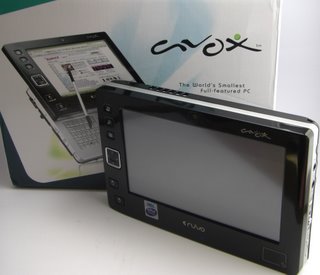
The vibrant world of UMPCs has many players, most of them well-known brands, others less so, but probably deserving our attention just the same. In this category you will find the Ruvo Avox, a handsome slider UMPC. Think of it as a Nokia N95 on steroids, but then a lot bigger! The Avox, whilst practically unknown, has a more familiar incarnation as the Gigabyte U60. Are they exactly the same?
We got ourselves the first Avox in Australia, courtesy of Tegatech, the UMPC distributor par excellence down under. They are excited about that little critter and I am beginning to see why!
Please follow me on this unboxing and our subsequent in-depth reviews of the Ruvo Avox.
First off, the Avox is billed as the smallest full-featured PC. In this fluid world of sub-notebooks and UMPCs that claim is probably correct but bragging rights are never long-lived and it is better to judge a device, particularly when it is this small, by its usability. So that will be the main focus of this and the following reviews.
Today we will be looking at the Avox from the unboxing perspective and go into the hardware details.
A next review will highlight the software and performance aspects to be followed by a write-up of all the various accessories that can be bought separately.
Let’s start with that by way of a teaser
Connectivity is a strong point with the Avox — as it should be. It’s the nature of an Ultra Mobile PC: you can take it anywhere and be connected to the Internet via WiFi or to other devices with Bluetooth. No big deal. The fun starts when you see what the docking station offers in terms of connectivity and flexibility. The docking station is not included in the purchase price of AUD1199. With the Australian dollar almost at parity with the US greenback, the Avox hovers around that sweet price point of US$1000. Other accessories make the box not only versatile but they may be essential in some applications. This is what is on offer: GPS, 3G, extra battery, TV tuner and DVD burner. More on all these options later.
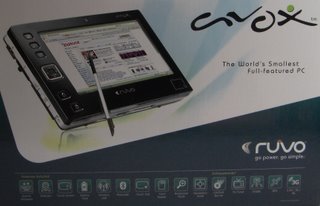 |
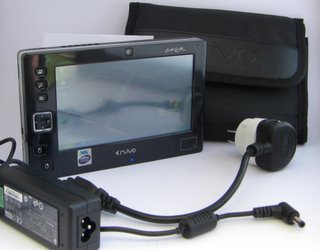 |
Unboxing a new device is that unique experience where you find out whether the reality meets your expectation. You’ve seen the pictures before, you’ve read about the specs but what does it feel like in your hands, what’s the keyboard like, battery life under load? How easy is it to use? What’s the build quality like? First impressions are important and I’m glad to report that my expectations were exceeded. The Avox is just about the right size for a handheld device running full Windows. It feels well-balanced in your hands, particularly when you use the keyboard in thumb typing. It feels slightly heavier than I would like it to be but it may also be due to the excellent build quality and heavier battery. The 6.5” 800×480 LCD TFT-LCD display with touch-sensitive screen has a very pleasant quality to it and even though you can use it in a higher resolution (it supports up to 1024×600) the native resolution looks best.
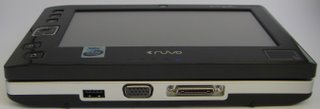 |
 |
Let’s do a quick walk around
A decent WebCam and two microphones grace the top bevel. On the left edge from top to bottom you find the following buttons: one to access the Mobility Centre Button under Vista but currently it’s set to the much more useful screen brightness settings (7 levels). Next, the Resolution Change Button where you can switch between four levels of display resolution and the Enter Button — handy for when you are not using the keyboard. There is a four way Scroll Button followed by a left mouse button and one for the right mouse functions. Bottom right you have the tiniest touchpad you ever come across! Small but effective. Most of the time you will be navigating using your fingers on the touchscreen. That’s the fastest way and if you need a greater precision you can always use the built-in stylus. Kudos to Ruvo for including a second one. I know it’s only 10 cents more in manufacturing but these things are the first to misplace or lose…
On the lower left-hand side — on the bottom slider keyboard that is — there is a USB port, an SD slot and the battery lock and latch.
Viewed from the right you’ll encounter the DC-In Jack, microphone and headphone jacks, the SAS switch to emulate Alt+Ctrl+Del, (I reckon they should have called it the SOS switch!) and the power/hold switch with a volume control rocker switch. Finally at the bottom another USB port, and VGA connector and a special one for the docking station. The underside accommodates the stylus, the Bay module connector for any optional accessories and also houses the speaker. Not a great place for a speaker but then again there ain’t a lot of room on the front, is there?
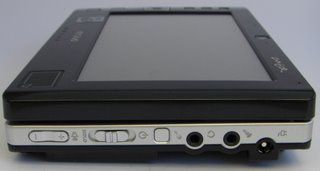 |
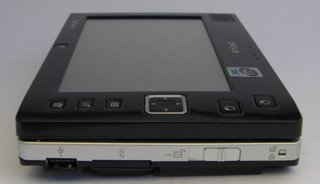 |
Split Personality
I’m not talking about myself in this paragraph although I can identify with split personalities. I am referring to the keyboard which is split into two halves or segments, easily accessible to either thumb. It’s a pretty full keyboard with the numbers keys doubling up as function keys. In the middle of the keyboard you have four communication buttons: these will give you quick access to Bluetooth and wireless LAN functions as well as switching on the WebCam and the Bay module. Yes, the keys are small, there is no way around it. With careful placement of my thumbs I did not make too many mistakes but if you do a lot of typing you may find this inadequate. I am surprised frankly that there is no tablet software standard on this machine. Handwriting recognition or even speech recognition, as built in with Vista, is very attractive on a mobile platform. But it is very much a function of power – or lack of it – that dictates what is possible.
The hard drive is a 1.8″ format, 30 GB affair. Not great as after a Windows install only some 23GB remain. Again, you have to consider the environment that you take the Avox into: it’s an away from home type of device for quick access to e-mail or your documents but it is not your main machine. As such, the hard drive should be sufficient as there are many ways of offloading the extra data.
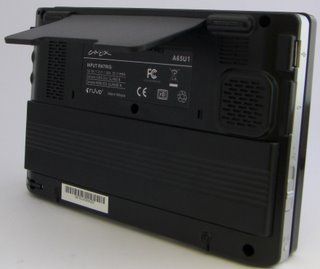 |
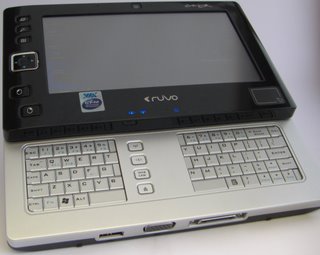 |
Initial Impressions
I’m pretty impressed with the unit so far given the constraints of the 1.2GHz VIA processor chip and the size of the box. Battery life is a reasonable 3 to 4 hours depending on brightness settings alone. We still have to see what it will be under WiFi load, etc. What I particularly appreciate in the Ruvo Avox is the absolute silence of the unit. The chip doesn’t need any extra cooling through fans and it is quite comfortable to have on your lap or in your hands for an extended period of time. I’ll tell you what: the “wife” factor is very high! She loves the Avox (keyboard is purrfect for her…).
In case you wonder – Ruvo is a division of the Taiwanese Hybrinx Technology company. They make notebooks as well and I would gladly give you their website but it is hopelessly out of date.
Observation:
Yes, you can get a lot more capacity, speed and features if you go for a notebook or desktop. You do pay more for tinier components. The portability of a UMPC outweighs that of most notebooks and even that of the Dialogue Flybook V33i which I have had for quite some time. The Flybook is arguably one of the best connected ultra-compact sub notebooks around but when you open up the Flybook it is twice as large as the Avox. Not everybody needs a UMPC but they can be extremely handy in certain vertical markets (think of home valuation, medical sectors and mobile sales applications) or as a large screen navigation device. We will report on those uses in an upcoming issue.
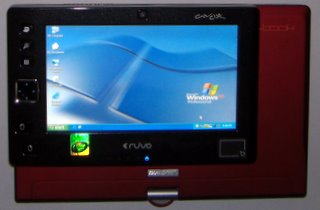 |
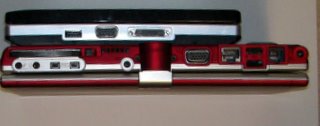 |
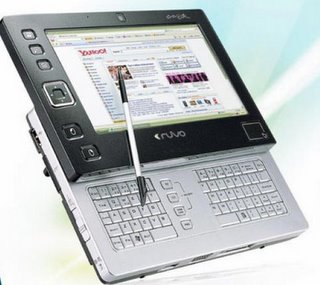 |
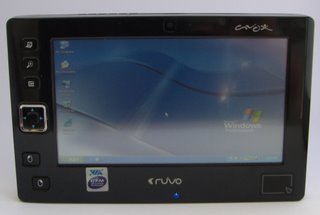 |
|
Specifications:
|


